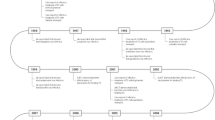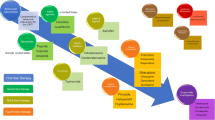Abstract
Purpose of Review
This article was written in order to bring the reader up to date with developments that have occurred in the treatment of Tourette disorder (TD) over the last 5 years.
Recent Findings
Despite the fact that TD has been recognized for over a century, the understanding of the underlying mechanisms remains poor. There has been limited development in the last 5 years for new therapeutic options.
Summary
Aripipazole is the only newly approved pharmaceutical therapy for TD in the last 5 years, although several medications are under active study. For the most severely affected individuals, there is increasing experience with surgical interventions. One of the most promising areas of research is the work of genetic consortiums currently looking into identifying the underlying pathogenetic basis which in turn will hopefully lead to the development of safer and more effective therapies.
Similar content being viewed by others
References
Papers of particular interest, published recently, have been highlighted as: • Of importance
Scharf JM, Miller LL, Matthews CA, et al. Prevalence of Tourette syndrome and chronic tics in the population-based Avon longitudinal study of parents and children cohort. J Am Acad Child Adolesc Psychiatry. 2012;51:192–201.
de la Tourette G. Etude sur une affection nerveuse caracterisee par de l’incoordination mortice accompagnee d’echolalie et de coprolalie [French]. Arch Neurol. 1885;9:158–200.
Robertson MM. The Gilles de la Tourette syndrome: the current status. Arch Dis Child Educ Pract Ed. 2012;97:166–75.
Bloch MH, Leckman JF. Clinical course of Tourette syndrome. J Psychosom Res. 2009;67(6):497–501.
Freeman RD, Fast DK, Burd L, Kerbeshian J, Robertson MM, Sandor P. An international perspective on Tourette syndrome: selected findings from 3,500 individuals in 22 countries. Dev Med Child Neurol. 2000;42:436–47.
Tourette Syndrome Association International Consortium for Genetics. Genome scan for Tourette disorder in affected sibling pair and multigenerational families. Am J Hum Genet. 2007;80:265–72.
• Georgitsi M, Wilsey AJ, Mathews CA, et al. The genetic etiology of Tourette syndrome: large-scale collaborative efforts on the precipice of discovery. Front Neurosci. 2016;10:351 This article highlights the large-scale efforts among large international organizations in unifying their efforts to uncover the full range of genetic variation and environmental risk factors. So far, it is proving to be quite complex and not likely the result of a single gene and therefore the genetics currently remains elusive.
Krack P, Hariz MI, Baunez C, Guridi J, Obeso JA. Deep brain stimulation: from neurology to psychiatry. Trends Neurosci. 2010;33:474–84.
Leckman JF, Bloch MH, Smith ME, Larabi D, Hampson M. Neurobiological substrates of Tourette’s disorder. J Child Adolesc Psychopharmacol. 2010;20:237–47.
Paschou P, Muller-Vahl K. Editorial: the neurobiology and genetics of Gilles de la Tourette syndrome: new avenues through large-scale collaborative projects. Front Psych. 2017;8:197.
Qi Y, Zheng Y, Li Z, Xiong L. Review: Progress in genetic studies of Tourette’s syndrome. Brain Sci. 2017;7:134. https://doi.org/10.3390/bricnsci710034.
Storch EA, De Nadai AS, Lewin AB, et al. Suicidal thoughts and behavior in children and adolescents with chronic tic disorders, depression and anxiety. Depress Anxiety. 2015;32(10):744–53.
Parraga HC, Harris KM, Karen BS, et al. An overview of the treatment of Tourette’s disorder and tics. J Child Adolesc Psychopharmacol. 2010;20(4):249.
Macguire JF, Piacentini J, Brennan EA, et al. A meta-analysis of behavior therapy for Tourette syndrome. J Psychiatr Res. 2014;50:106–12.
Woods DW, Miltenberger RG, Lumley VA. Sequential application of major habit-reversal components to treat motor tics in children. J Appl Behav Anal. 1996;29(4):483–93.
Macguire JF. Behavior therapy for youth with Tourette disorder. J Clin Psychol In Session. 2016;72(11):1191–9.
• Frundt O, Woods D, Ganos C. Behavioral therapy for Tourette syndrome and chronic tic disorders. Neurol Clin Pract. 2017;7:148–56 The management of tic disorders involves both behavioral and pharmacologic treatment practices. This article emphasizes that habit reversal training, comprehensive behavioral interventions, and exposure and response prevention are still the first-line behavioral interventions. These could be more widely implemented using internet-based and telehealth approaches. Other techniques such as autonomic modulation or attention-based interventions with neurofeedback may also hold therapeutic promise.
Shapiro AK, Shapiro E. Treatment of Gilles de la Tourette’s syndrome with haloperidol. Br J Psychiatry. 1968;114:345–50.
• Sallee F, Kohegyi E, Zhao J, et al. Randomized, double-blind, placebo-controlled trial demonstrates the efficacy and safety of oral aripiprazole for the treatment of Tourette’s Disorder in children and adolescents. J Child Adolesc Psychopharmacol. 2017;279:771–8 This randomized double-blind placebo-controlled study demonstrated efficacy and safety of high- and low-dose aripiprazole for the treatment of TD in children and adolescents. With a reduction of 45.9% and 54.2% from baseline observed in low- and high-dose groups, respectively, this drug was generally well tolerated.
Marras C, Andres D, Sime E, Lang AE. Botulinum toxin for simple motor tics: a randomized, double-blind, controlled clinical trial. Neurology. 2001;56:605–10.
• Pichler E, Kawohl W, Seifritz E, Roser P. Pure delta-9-tetrahydrocannabinol and its combination with cannabidiol in treatment-resistant Tourette syndrome: a case report. Int J Psych Med. 2019;54(2):150–6. This case report highlighted the benefit of cannabidiol and delta-9-tetrahydrocannabinol with rapid and significant improvement in the Yale Global Tic Severity Scale. This was only a single patient however.
Cohen SC, Mulqueen JM, Ferracioli-Oda E, Stuckelman ZD, Coughlin CG, Leckman JF, et al. Meta-analysis: risk of tics associated with psychostimulant use in randomized, placebo-controlled trials. J Am Acad Child Adolesc Psychiatry. 2015;54:728–36.
Hirota T, Schwartz S, Correll CU. Alpha-2 agonists for attention-deficit/hyperactivity disorder in youth: a systematic review and meta-analysis of monotherapy and add-on trials to stimulant therapy. J Am Acad Child Adolesc Psychiatry. 2014;53(2):153–73.
Le K, Liu L, Sun M, et al. Transcranial magnetic stimulation at 1 hertz improves clinical symptoms in children with Tourette syndrome for at least 6 month. J Clin Neurosci. 2013;20:257–62.
Kwon HJ, Lim WS, Lim MH, Lee SJ, Hyun JK, Chae J-H, et al. 1-Hz low frequency repetitive transcranial magnetic stimulation in children with Tourette’s syndrome. Neurosci Lett. 2011;492(1):1–4.
• Hsu C-W, Wang L-J, Lin P-Y. Efficacy of repetitive transcranial magnetic stimulation for Tourette syndrome: a systematic review and meta-analysis. Brain Stimul. 2018;11(5):1110–8 This is a systematic review and meta-analysis of the literature using rTMS for treatment in TD. This paper suggests that treating younger patients might be associated with better outcomes.
• Eapen V, Baker R, Walter A, et al. The role of transcranial direct current stimulation (tDCS) in Tourette syndrome: a review and preliminary findings. Brain Sci. 2017;7:161 This is a review on the literature using tDCS in commonly occurring comorbid conditions relevant to its proposed use in TD. This treatment was overall found to be safe and well tolerated. There is some data to suggest that the treatment is effective over the course of the treatment period with unknown benefits in longer term. The authors proposed a design for large prospective studies to truly evaluate long-term efficacy.
Kekic M, Boysen E, Campbell IC, Schmidt U. A systematic review of the clinical efficacy of transcranial direct current stimulation (tDCS) in psychiatric disorders. J Psychiatr Res. 2016;74:70–86.
Vandewalle V, van der Linden C, Groenewegen HJ, Caemaert J. Stereotactic treatment of Gilles de la Tourette syndrome by high frequency stimulation of the thalamus. Lancet. 1999;353:724.
Sachdev PS, Mohan A, Cannon E, et al. Deep brain stimulation of the antero-medial globus pallidus intenus. Mov Disord. 2011;26(10):1922–30.
Schrock LE, Mink JW, Woods DW, Porta M, Servello D, Visser-Vandewalle V, et al. Tourette syndrome deep brain stimulation: a review and updated recommendations. Mov Disord. 2015;30:448–71.
Lehman LL, Gilbert JL, Leach SW, et al. Vertebral artery dissection leading to stroke caused by violent neck tics of Tourette syndrome. Neurology. 2011;77(18):1706–8.
Huasen B, McCreary R, Evans J, Potter G, Silverdale M. Cervical myelopathy secondary to Tourette’s syndrome managed by urgent deep brain stimulation. Mov Disord. 2014;29(4):452–3.
• Martinez-Ramirez D, Jimenez-Shahed J, Leckman JF, et al. Efficacy and safety of deep brain stimulation in Tourette syndrome: the International Tourette Syndrome Deep Brain Stimulation Public Database and Registry. JAMA Neurol. 2018;75(3):353–9 This article provides outcomes in a prospective international Deep Brain Stimulation Database and Registry including 185 patients with medically refractory TD. These patients were implanted between January 2012 and December 2016 in 10 countries worldwide. The most common target was the centromedian thalamic region in 57.1%. There was a statistically significant reduction in the mean total Yale Global Tic Severity Scale score, mean motor tic subscore, and phonic tic subscore at 1 year after implantation. The overall adverse event rate was 35.4% with the most common adverse effects being dysarthria (6.3%) and paresthesias (8.2%) with hemorrhages in 1.3% of patients, infection in 3.2%, and explantation or removal in 0.6%.
Guo JN, Kothari JS, Leckman JF, Ostroff RB. Successful treatment of Tourette syndrome with electroconvulsive therapy: a case report. Biol Psychiatry. 2016;79(5):e13–4.
Dehning S, Feddersen B, Mehrkens JH, Muller N. Long-term results of electroconvulsive therapy in severe Gilles de la Tourette syndrome. J ECT. 2011;27:145–7.
Author information
Authors and Affiliations
Corresponding author
Ethics declarations
Conflict of Interest
The authors declare that they have no conflict of interest.
Human and Animal Rights and Informed Consent
This article does not contain any studies with human or animal subjects performed by any of the authors.
Additional information
Publisher’s Note
Springer Nature remains neutral with regard to jurisdictional claims in published maps and institutional affiliations.
This article is part of the Topical Collection on Child and Adolescent Disorders




